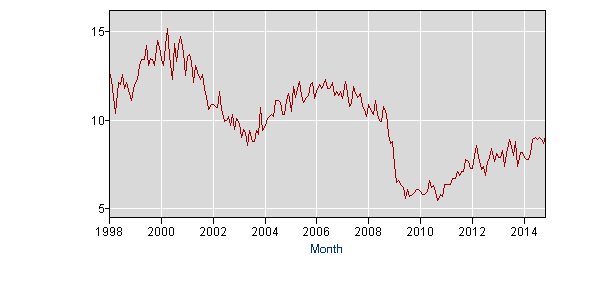December 06, 2014
The November jobs numbers were unambiguously good news. The economy is moving in the right direction and at a faster pace than we had seen in years. But we have to realize how far the labor market has to go before it makes up the ground lost in the recession.
The simplest and best measure is the employment to population ratio (EPOP), which gives the percentage of the adult population which is employed. This stood at 59.2 percent in November (unchanged from October). This is 1.0 percentage points above the low of 58.2 percent last hit in the summer of 2011, but it is still more than four full percentage points below the pre-recession peaks and more than five full percentage points below the all-time highs hit in 2000.
Many people have dismissed these comparisons by pointing to demographic changes, specifically the aging of the baby boomers. With much of the baby boom cohort now in their sixties, we would expect to see more people retiring, but if we look at prime age workers (ages 25-54) we get a similar story. The OECD reports that the EPOP for this group was 76.8 percent in the third quarter of this year, compared to 79.9 percent in 2007 and 81.5 percent in 2000. People in their thirties and forties have not just suddenly decided that they want to retire. This drop in employment is almost certainly due to the weakness of demand in the labor market.
Some other measures of slack are also useful to note. Some reports have noted the upturn in quit rates as reported in the Job Opening and Labor Turnover Survey. The most recent data puts the quit rate at 2.0 percent compared to a low of 1.3 percent at the trough of the recession. This means that more people are prepared to quit a job with which they are unhappy. But this figure is still down from 2.2 percent as a year-round average in 2006. (We should remember that even in the pre-recession period, the labor market was just getting tight enough to see some wage growth.) The quit rate at the end of 2000 and start of 2001, when the survey began, was as high as 2.6 percent. (When considering these numbers it is important to realize that the shift in employment over this period from low quit sectors like manufacturing to high quit sectors like restaurants would have added at least 0.1-0.2 percentage points to the quit rate.)
We can also look at the percentage of unemployment that is due to people who have voluntarily quit their jobs. This rose to 9.1 percent in November, the highest level in the recovery. However, this is still below the 11 percent rates seen before the recession and well below the 14 percent rates seen at the end of the 1990s and 2000.
Percentage of Unemployment Due to People Voluntarily Leaving Jobs

Source: Bureau of Labor Statistics.
Given the continuing weakness of the labor market, it is not surprising that workers are still seeing little of the benefits from economic growth. To restore the same degree of tightness in the labor market that we had in 2007, we would need 2.5 years of job growth like we saw in November. To get back to the labor market of the late 1990s and 2000 we would need 3.5 years of November’s growth.
In short, there are really no surprises in this picture. A weak labor market leads to a situation in which most workers don’t benefit from economic growth. Unfortunately we are still far away from getting to a point where we can anticipate substantial real wage gains, even if the November jobs numbers are a step in the right direction.







Comments